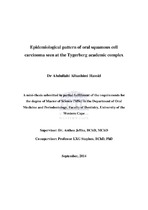| dc.contributor.advisor | Jeftha, Anthea | |
| dc.contributor.advisor | Stephen, L.X.G. | |
| dc.contributor.author | Hamid, Abdullahi Alhashimi | |
| dc.date.accessioned | 2015-05-29T09:01:56Z | |
| dc.date.available | 2015-05-29T09:01:56Z | |
| dc.date.issued | 2014 | |
| dc.identifier.uri | http://hdl.handle.net/11394/4226 | |
| dc.description | Magister Scientiae Dentium - MSc(Dent) | en_US |
| dc.description.abstract | Background: Recent epidemiological reports established that there is an increase in
the incidence of oral squamous cell carcinoma in young patients. Some report this to be in the absence of contributing habits such as smoking and alcohol use. Few reports of such a nature have reported a similar trend in South Africa. Aim: Describe the epidemiological pattern of oral squamous cell carcinoma seen at the Tygerberg academic complex. Method: Histopathological biopsy reports of patients diagnosed by the oral pathology department of Tygerberg hospital from 1996 to 2013 were electronically retrieved and included. Patients were grouped by age into two groups, one included patients 40 years and younger, the other included patients older than 40 years. Descriptive analysis was performed for age, sex, smoking and alcohol habits and oral site of tumor. Frequency of OSCC patients was calculated manually from the total number of oral biopsies. Chi- square or Fisher’s exact tests were used as appropriate. Probabilities of less than 0.05 were regarded as significant. Results: The total number of OSCC patients over the 18-year period was 2220. The mean age was 57.6years.The male to female ratio was 2.9:1 for all age groups and 2.2:1 for young patients. The majority of patients (96%) were above 40 years old. Smoking and alcohol were commonly reported for all age groups (91.3%) and (83.8%) for young patients. The tongue was the commonest site for all age groups (30.8%) followed by oropharynx (27.3%) while in younger patients, the oropharynx was the commonest site (30.3%) followed by tongue (29.2%). Conclusion: The study confirmed that OSCC is still an affliction of people older than 40 years and males are predominantly affected. Smoking and alcohol are strong risk factors for OSCC irrespective of patient's age. OSCC among people older than 40 years may have no great difference from the same disease affecting younger ones in terms of sex, oral habits and tumor site. | en_US |
| dc.language.iso | en | en_US |
| dc.publisher | University of the Western Cape | en_US |
| dc.subject | Oral | en_US |
| dc.subject | Epidemiology | en_US |
| dc.subject | Squamous cell carcinoma | en_US |
| dc.subject | Tygerberg | en_US |
| dc.title | Epidemiological pattern of oral squamous cell carcinoma seen at the Tygerberg academic complex | en_US |
| dc.rights.holder | University of the Western Cape | en_US |

